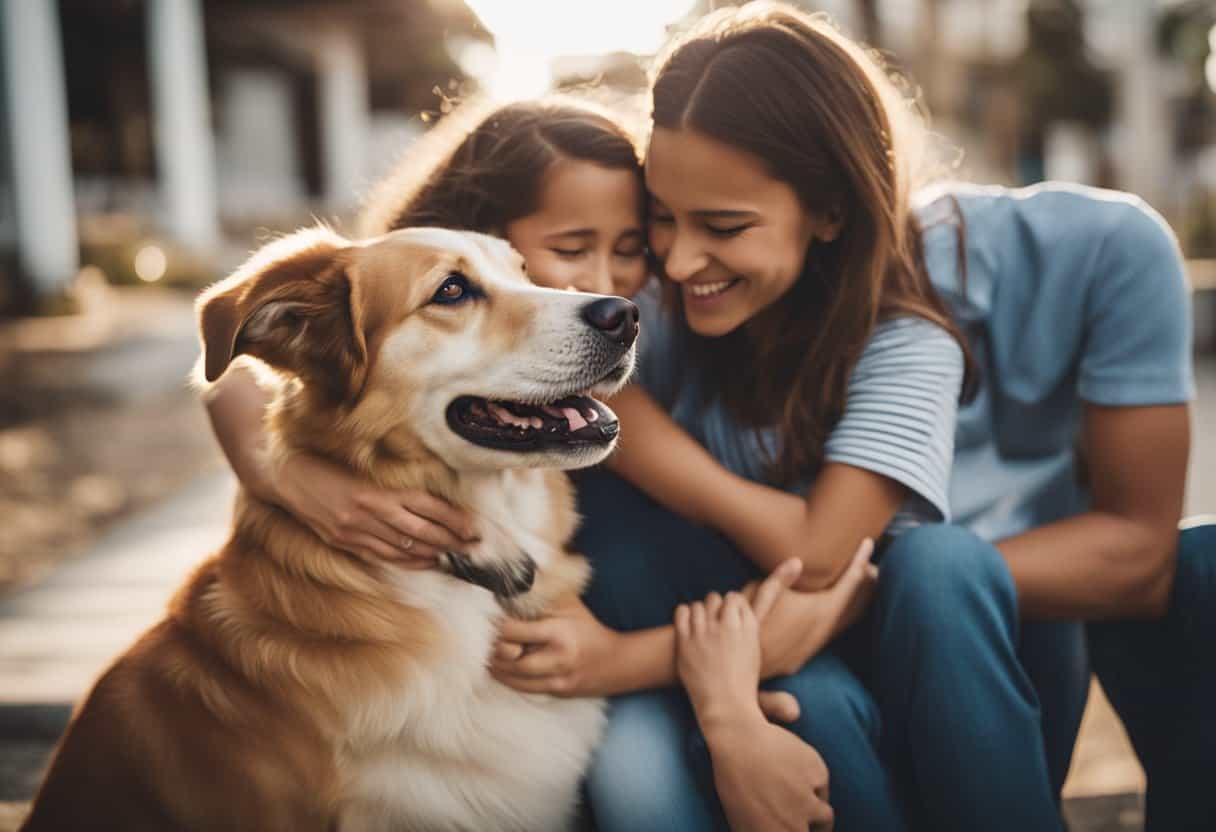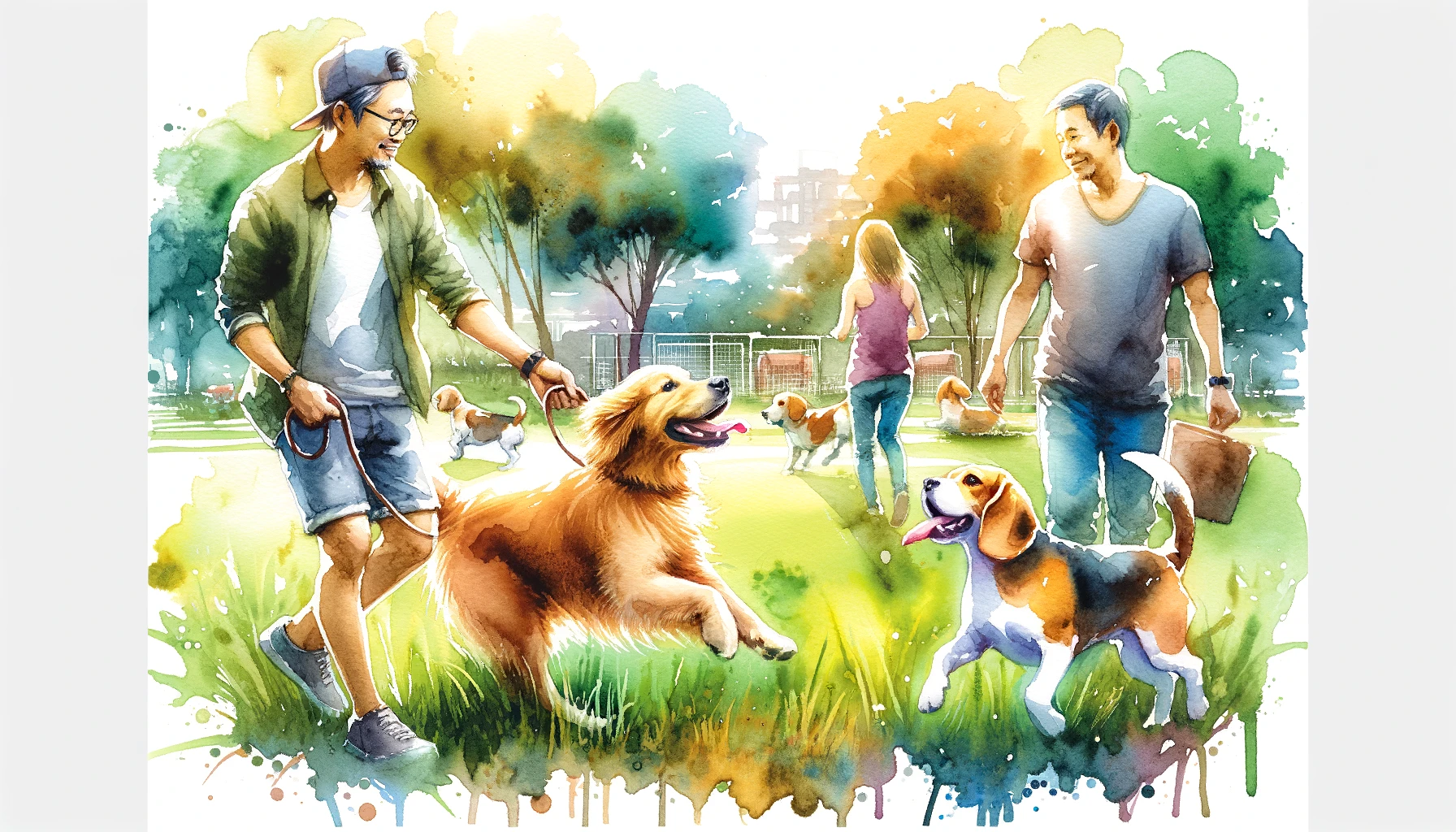This post may contain ads and affiliate links and we may earn a small commission when you click on the links at no additional cost to you. As an Amazon Affiliate, we earn from qualifying purchases. You can read our full disclaimer here.
Emotional Benefits of Dog Fostering: Well-being with Compassion

The emotional benefits of dog fostering are numerous and deeply impactful.
When you foster a dog, you do more than just enjoy the company of a pet. You tap into a special kind of joy.
This joy comes from knowing you’re giving a temporary home to a dog in need. It’s a unique feeling, one that fills you with a sense of purpose and fulfillment.
Emotional Benefits of Dog Fostering
Fostering a dog means you’re directly involved in their care and rehabilitation. It’s a hands-on experience that allows you to witness their growth and progress. This process can be incredibly rewarding.
You’re not just a temporary caretaker; you become a pivotal part of their journey towards a better life.
Moreover, the unconditional love and affection a dog offers in return is a heartwarming bonus. It’s a mutual exchange of care and affection, making the fostering experience emotionally enriching for both you and the dog.

The act of dog fostering can also contribute to your happiness by fostering a sense of purpose. Taking care of a dog’s daily needs, helping them adjust to a new environment, and working on their socialization skills can provide structure to your day and a clear set of rewarding responsibilities.
Additionally, integrating a foster dog into your life can lead to an increase in social interactions, as it encourages outings and can serve as a conversation starter with other dog lovers.
Key Takeaways of Emotional Benefits of Dog Fostering
- Fostering a dog provides emotional fulfillment through caring for a dog in need.
- The responsibilities of fostering can enhance your sense of purpose and daily happiness.
- It may increase socialization opportunities and improve your overall social life.
The Emotional Rewards of Fostering Dogs

Fostering dogs offers a unique blend of emotional rewards ranging from the deep bonds formed to the tangible health benefits.
Bonding and Companionship
When you choose to foster a canine companion, you embark on a journey of bonding that brings immeasurable happiness. This connection is not just heartwarming but also deeply fulfilling, as you become a trusted figure in the dog’s life.
- Benefits of Bonding: Experience love and companionship; a sense of fulfillment.
- Daily Interactions: Share moments of joy through play and relaxation.
Healing and Personal Growth
Your role in a foster dog’s life can genuinely impact your own path of healing and personal growth. As you aid in their recovery, you may find solace and a sense of purpose that contributes to your emotional well-being.
- Healing Through Caring: Engage in the recovery process; mutual healing.
- Personal Evolution: Learn patience and consistency; foster resilience.
Emotional Benefits of Dog Fostering and Its Impact on Mental Health
By fostering dogs, you support your mental health. The companionship of a dog has been shown to lower cortisol levels and blood pressure, which can reduce stress and enhance your overall mood.
- Health Benefits:
- Reduced Stress: Decreased cortisol levels.
- Better Mood: Lower blood pressure and uplifted spirits.
Facing and Overcoming Challenges
The process of fostering includes facing challenges such as behavioral issues or medical needs. Overcoming these obstacles rewards you with a sense of accomplishment and strengthens your problem-solving skills.
- Challenges: Address and manage unique needs; behavioral training.
- Overcoming: Build patience and problem-solving abilities; a rewarding experience.
Understanding the Emotional Benefits of Dog Fostering

Dog fostering is a temporary caregiving arrangement where you welcome a foster dog into your home. By doing so, you provide a loving environment away from the stress of the shelter, bridging the gap between rescue and finding a forever home.
Fostering Vs. Adoption
When you foster a dog, it’s a short-term commitment, where your role is to nurture and prepare the dog for adoption. Adoption is a permanent arrangement where the dog becomes a lasting member of your family.
Fostering helps shelters manage space and resources, while adoption gives a dog a permanent home.
- Fostering: Temporary, crucial for dog’s transitional phase.
- Adoption: Permanent, long-term commitment to a dog.
The Role of Foster Homes
As a foster home, you play a significant role in a dog’s life. Your home environment becomes a sanctuary for healing and growth. Foster homes often assist with socialization, basic training, and may sometimes address behavioral issues.
The primary goal is to provide a safe, nurturing place that allows the dog to thrive and become more adoptable.
- Foster Care Goals:
- Aid in socialization and training.
- Offer a safe and nurturing environment.
- Increase the dog’s adoptability.
Preparation and Requirements
Before fostering a dog, it’s essential to assess your living situation for safety and suitability. You’ll need to gather necessary supplies such as food, bedding, and toys. Some shelters provide these, while others may require you to supply them.
Preparation Checklist:
- Secure, pet-friendly living space.
- Food, water bowls, and bedding.
- Toys and grooming supplies.
- Commitment to the dog’s well-being.
Understanding your lifestyle and limitations is crucial, as each dog has unique needs. Safety measures should be in place to prevent escape or injury.
Finally, most fostering programs will require an application process to ensure that your home is a suitable match for fostering a dog.
Emotional Benefits of Dog Fostering: Integration and Socialization

Integrating a foster dog into your home can greatly enhance their socialization skills and prepare them for successful interactions with humans and potential adopters.
From Shelter to Foster
Transitioning a shelter dog to your home involves creating a secure environment to facilitate their adjustment. Establish routines immediately, including scheduled feeding times and potty breaks.
Observe the dog’s behavior to assess their comfort level with different spaces in the home.
- Initial Adjustments:
- Secure, quiet space: Provide a rest area where the dog feels safe.
- Routine establishment: Consistency builds trust and a sense of security.
Interactions with Humans and Pets
By fostering, you expose the shelter dog to diverse social scenarios, enhancing their communication and social skills. Interact with the dog regularly using clear, consistent commands to strengthen obedience.
Gradually introduce them to new people, ensuring controlled encounters, especially with children. If other pets are present, carefully manage initial interactions to prevent stress or aggression.
- Human Socialization:
- Adults and children: Gradual introductions to various people.
- Obedience Training: Implement basic commands to improve interaction.
- Pet Integration:
- Cats and other dogs: Supervised meetings to foster positive pet relationships.
Preparing for Adoption
Foster dogs learn to form attachments during their stay, which is crucial for their emotional well-being. Showcase their progress on social media to engage potential adopters, giving insight into the dog’s personality and adaptability.
Your input is vital in the adoption process; provide feedback about the dog’s response to socialization and readiness for a forever home.
- Adoption Process:
- Social media exposure: Highlight the dog’s journey and milestones to attract adopters.
- Readiness feedback: Give informed updates on the dog’s behavior and compatibility.
Logistics of Dog Fostering

In fostering a dog, you’ll deal with various logistical aspects, from managing expenses to working with shelters for support. Familiarizing yourself with these details will ensure a smooth fostering experience.
Financial and Material Considerations
When you decide to foster a dog, understanding the financial and material costs is essential. First, examine the expenses you’ll likely incur:
- Supplies: Including food, bedding, crates, toys, and grooming tools.
- Veterinary care: Ranging from routine check-ups to emergency visits.
Keep in mind, some animal shelters provide a shelter medicine program that may cover certain medical expenses.
| Expense | Estimate | Provided by Shelter? |
|---|---|---|
| Food | $20-$60/month | Sometimes |
| Bedding | $30-$100 (one-time) | Rarely |
| Crates | $50-$150 (one-time) | Sometimes |
| Toys and grooming | $10-$50 | Rarely |
| Veterinary Care | Varies widely | Often |
A good practice is to outline your budget and discuss with the shelter what supply costs are your responsibility.
Understanding Shelter Support
Your collaboration with animal shelters is vital. They often offer varying degrees of support:
- Supplies: Some shelters supply the basics – check what’s available.
- Veterinary care: Shelters typically have veterinary support for fostered pets; confirm what’s covered.
- Emergency Protocols: Know how the shelter handles emergencies, including after-hours incidents.
Establishing a clear line of communication is crucial to ensuring that you get the support needed throughout your fostering journey.
Challenges and Considerations
In fostering dogs, you are likely to encounter behavioral issues and face emotional challenges, particularly when it’s time to say goodbye.
It’s also crucial to manage your expectations about the experience to align with reality.

Common Behavioral Issues
When fostering shelter dogs, behavioral issues stemming from past experiences are common. These can include:
- Aggression: Dogs may display signs of aggression as a defensive response to fear or prior trauma.
- Separation Anxiety: A foster dog may become anxious when left alone, often resulting from a fear of abandonment.
- Fear: New environments and people can trigger a fear response, leading to wary or skittish behavior.
Understanding and compassion are essential when addressing these behaviors, with a focus on creating a stable environment and providing consistent training.
Saying Goodbye to Foster Dogs
The process of saying goodbye to a foster dog can be deeply emotional. You may develop a strong attachment, making the separation challenging. Here are two key points:
- Transition: Preparing for the dog’s transition to a permanent home is important for both the dog and you.
- Attachment: Acknowledging your feelings of loss reflects the care and connection you’ve fostered.
Stay focused on the positive impact you’ve had on the dog’s life and the crucial role you play in combating shelter overcrowding and euthanasia by fostering.
Managing Expectations
Fostering should come with a reality check:
- Expect the Unexpected: Not all foster experiences will align with your initial expectations.
- Surrendered Dogs: Remember that dogs you foster may have been surrendered for various reasons, affecting their behavior and the care they need.
Stay informed and realistic about the responsibilities and potential challenges involved in fostering to ensure it’s a beneficial experience for both you and the dog.
Frequently Asked Questions
Fostering dogs can significantly benefit your mental health and emotional well-being. The following FAQs address how dog fostering can affect humans on an emotional level.
How does fostering dogs impact human mental health?
When you foster dogs, you provide care and companionship to animals in need, which in return can foster a sense of purpose and fulfillment in your life. This feeling of contributing to a greater good can enhance your overall mental health.
In what ways can fostering dogs provide emotional support to individuals?
Being a foster parent to dogs allows you to form close bonds with animals, offering unconditional love and presence. These strong emotional connections can act as a form of emotional support, helping you combat feelings of isolation and providing comfort.
What are some psychological advantages of participating in dog fostering programs?
Dog fostering programs often give you a sense of community and belonging as you interact with other foster carers and shelter staff. This social aspect, combined with the responsibility of caring for a dog, can enhance self-esteem and promote a positive mental outlook.
Can engaging in dog fostering activities reduce feelings of loneliness or depression?
Yes, engaging with a foster dog can serve as a companion to you, reducing your feelings of loneliness. The routine and responsibility of caring for a dog may also provide structure that can help alleviate symptoms of depression.
How does the presence of a foster dog influence stress levels in humans?
The presence of a foster dog in your home can lead to increased levels of the hormone oxytocin in your body, which promotes feelings of relaxation and reduces stress. Additionally, engaging in play and physical activity with the dog can be a natural stress reliever.
What emotional growth opportunities can arise from the experience of dog fostering?
Through dog fostering, you may develop greater empathy and patience, as you learn to respond to the needs of an animal. These experiences can teach you valuable emotional skills that translate into other relationships and aspects of life.
Final Thoughts on the Emotional Benefits of Dog Fostering
In conclusion, fostering a dog offers a profound and enriching emotional experience. It goes beyond the simple act of caring for a pet; it’s about forming a bond with a creature in need and experiencing the joy and fulfillment that comes from making a positive impact in their lives.
Whether it’s the shared moments of happiness, the mutual affection, or the sense of purpose and responsibility, the emotional benefits of dog fostering are as rewarding as they are varied.
This journey not only changes the lives of these dogs but also deeply enriches the lives of those who choose to open their hearts and homes to them.
-

Coffee Mug – In Dog Coffees I’ve Only Had One
$11.95 – $14.95 Select options This product has multiple variants. The options may be chosen on the product page
